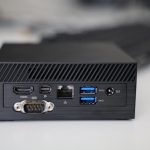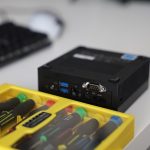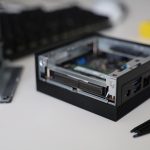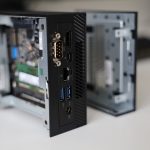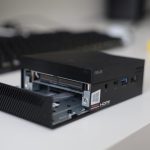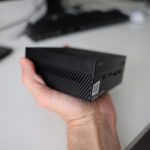When I think about PCs, I think about them in 2 form factors.. A laptop for portability and a performance rig for gaming. The reality is, there’s a whole other class of computing that is available for those with different needs.
If you’re someone who has a home office and needs a computer for basic PC needs like running office, checking email, browsing the web, then the Asus Mini PC PN40 fits the bill perfectly. Given these low-end requirements, a small PC that literally fits in the palm of your hand, or straps to the back of your monitor, is a perfect solution.
The PN40 is also quite and low power, so when you need a PC to drive a larger monitor (or even multi-monitor) experience, then this is a great solution to the problem.
Sometimes in business situations, you need a PC to powers displays for advertising, or increasingly business analytics, powered through platforms like PowerBI. In these circumstances, you can’t get away with a smart TV, you need an actual PC that can connect to the right resources and this would fit the bill perfectly.
Another potential audience for this category of device is kids. Maybe your kids are just starting out. While learning how to build a PC may be something they learn in the future, to start with, you just want something that works. Given this may end up on a small desk in their bedroom, the small footprint really is appreciated.
My first PC was in a medium tower case and to be honest, everything I did on it, is possible in this tiny footprint, an amazing example of how far we’ve come in terms of minaturisaton. Before we get into the review, it is important to remember what this isn’t. This PC has no dedicated GPU, so don’t expect to be playing the latest games on it, but for driving productivity apps, it’ll do a great job.


DESIGN
Small and stylish, on display or not
The exterior of this chassis features a modern black, brushed metal finish, that easily blends into it’s surroundings, complimenting the typical black monitor, keyboard and mouse. The ultra-compact design means you may mount it behind a display and hide it completely, perfect for those who love minimal workstations.
At just 115 x 115 x 49mm in size and 700 grams, a bit of double sided tape would secure it under the desk or behind the display. If you choose the later, it basically turns the display and PC into a all-in-one solution.
Despite the small form-factor, the device is upgradable. Unscrew 4 screws in the base and the chassis lets you slide off the lid and add or upgrade a M.2 SSD, 2.5-inch HDD or SSD, or memory. Something I really love is that Asus will actually sell you a bare-bones option, so you don’t have to waste money on components you don’t want. This lets you customize your system to meet your needs and budget perfectly.
The front offers all the expected ports, 3.5mm jack for audio, a USB-C, USB3.0 and USB2.0 ports, as well as the power button to turn on the device. The rear features a HDMI, mini-DP, (old school) VGA port so you have the necessary options to connect multiple displays. While the PN40 has WiFi, there’s also a Gigabit Ethernet port available as well as 2 more USB3.0 ports.
The base, side and rear of the chassis features vents that allows the heat to be dispersed without fans, which means this thing is basically silent. I also appreciated the 4 rubberised feet which means its it won’t scratch or slide on your benchtop.
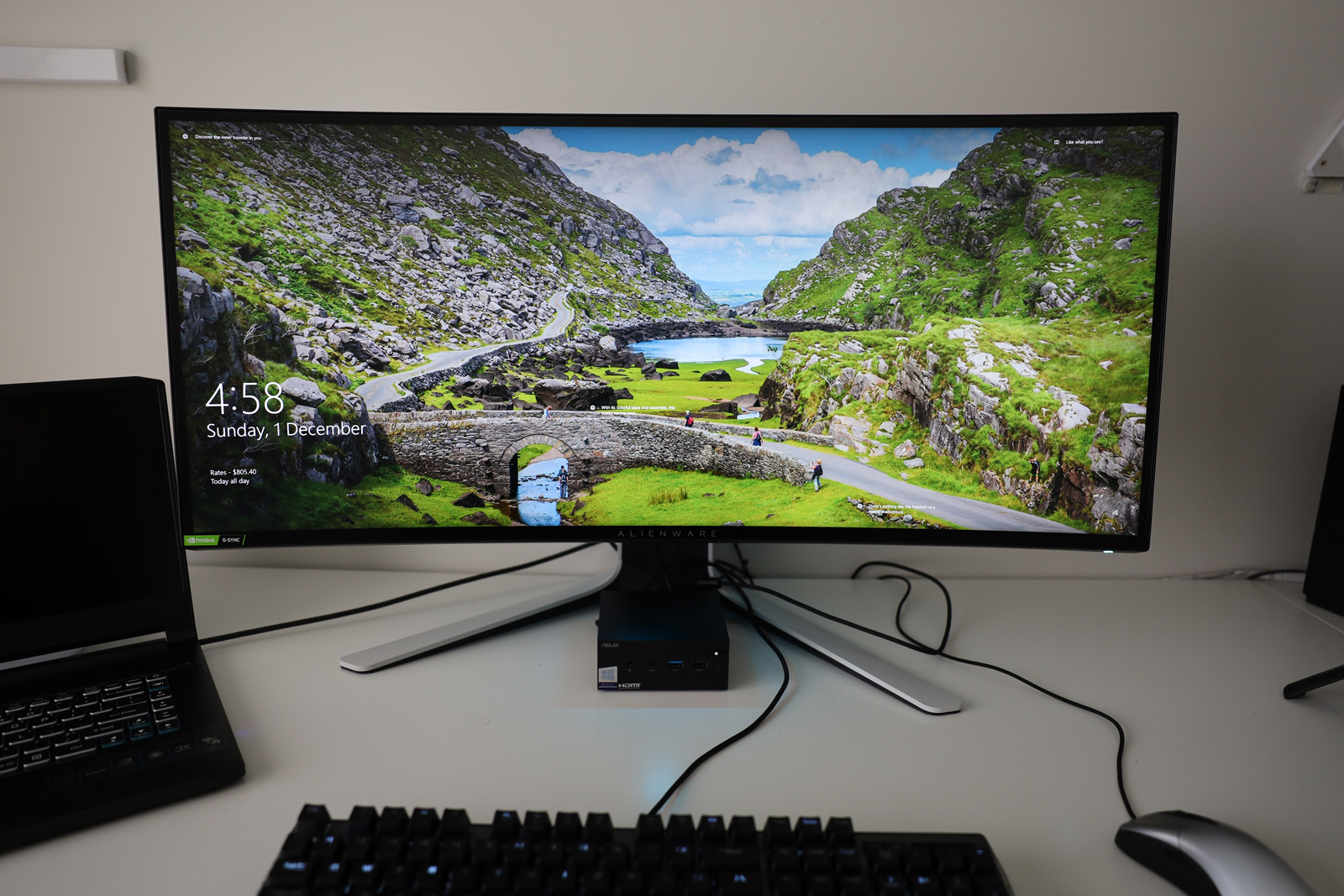

PERFORMANCE
How does it perform ?
The PN40 comes in a number of configurations, with the model I reviewed featuring an Intel Intel Celeron N4000 Processor running at 1.1Ghz. There’s just 4GB of DDR4 RAM inside, but that can be expanded up to 8GB. The on-board graphics is Intel’s UHD Graphics 600, certainly not a performance spec, but to be honest, this combination actually powers a really great Windows 10 experience.
In terms of the software, our review device came with Windows 10 Pro, a real credit to Asus, as I’ve often criticised laptop makers with premium price tags, still shipping Windows 10 Home.
By comparison, running it through PCMark10, the review configuration got just 1,394 points. This is definitely on the lower end of the performance rating, compared to all other machines I’ve tested, but that’s kind of the point. Windows 10 has fairly low requirements these days and just running something like Office on it will work fine. By comparison, a gaming laptop (sure it has an RTX2060) achieved a score of 5319, a full 3.8 times the performance of this, but that’s thousands of dollars, or many multiples of the price tag.

In fact I was quite impressed just how capable the machine is with web-based tasks I regular require a PC for. Much of this post, including some basic image editing, was written using the ASUS PN40 Mini PC. There are definitely times where it wouldn’t make sense, like editing 4K footage from a drone, but for most posts, which are a combination of reading emails, browsing the web, and writing content, this would work great.
While we’re constantly amazed by the performance in our phones, there’s still not a popular solution to connect your phone to a full-sized keyboard, mouse and display and that’s the only way to achieve serious multi-window productivity. My review of this device also overlapped with another review, of the Alienware 34″ curved gaming monitor. The device was easily able to power the 3440×1440 pixels which really makes for a nice desktop experience. The boot times were great and as I said earlier, I was actually really surprised just how capable this device is for its size and price.


ISSUES
Not everything’s perfect
Easily my biggest gripe with the configuration of the Mini PC I received was the tiny 60GB drive it came with. Once Windows, the preloaded applications and a couple of my apps were installed, I had right around 10GB free to do what I wanted. That’s really not enough for modern computing, even if you do live entirely in the cloud. I’d easily fill that with my downloads folder alone.
Thankfully this is one of the easiest problems to solve, just open the case and slot in some extra storage. It’s actually a shame the Mini PC doesn’t feature a microSD slot, I have a few spare 32GB cards that could have worked a treat.


PRICE & AVAILABILITY
How much and when can you get one ?
The price of the Asus Mini PC PN40 depends on the configuration that you select. While our specific review spec wasn’t easy to find, this one at Mwave was fairly close and is representative of the cheap pricetag. At A$349.00 it represents a really cheap PC and what’s great is that you’re not being hit with a premium price for the minaturisation of the components inside.
For what’s on offer here with the design, passive cooling and moderate performance, along with the option to upgrade components and Windows 10 Pro, this represents great value for money. By the time you add a cheap monitor, you could be out the door for around $500.
If you pair it with a larger display, like a cheap 55″ display for business situations and you could still have change for A$1,000 which is kind of crazy. Often we see business still rely on printed data to showcase business goals and project outcomes, but with a combination like this, you have to ask the question, why not keep everything digital and have live and always up-to-date data instead, it really is affordable.


OVERALL
Final thoughts
Reviewing this device really helped open my eyes to this often forgotten about category of PCs. While laptops certainly still dominate, those who have needs to power a perminant setup, either in the office, home office, or kids room, then you should definitely consider the Asus version of the Intel NUC.
If the PN40 looks a little light on in regards to specs, then you may want to consider the newer PN60 model of their mini PC.




